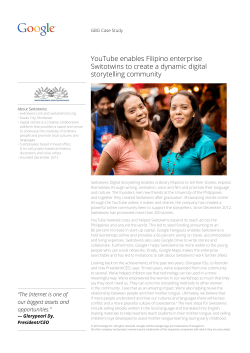
PaaS - Platform as a Service
PaaS - Platform as a Service Google App Engine Pelle Jakovits 14 April, 2015, Tartu Outline • Introduction to PaaS • Google Cloud • Google AppEngine – DEMO - Creating applications – Available Google Services – Costs & Quotas • Amazon Beanstalk& Elastic MapReduce • Windows Azure PaaS • PaaS Advantages & Disadvantages 2 Cloud Services 3 Platform as a Service - PaaS • Users are provided with a full platform for their applications • Enables businesses to build and run web-based, custom applications in an on-demand fashion • Eliminates the expense and complexity of selecting, purchasing, configuring, and managing hardware and software. • Provides access to unlimited computing power • Decreasing upfront costs dramatically 4 PaaS Characteristics • • • • Multi-tenant architecture Built-in scalability of deployed software Integrated with web services and databases Users are provided with tools to simplify creating and deploying applications • Simplifies prototyping and deploying startup solutions 5 PaaS Characteristics • Users only pay for services they use • More fine grained cost model • Provides tools to handle billing and subscription management • Typically introduces vendor lock-in 6 Types of PaaS • Stand Alone Application Platforms – Typically built on top of an existing IaaS – Provides development tools for designing and deploying software. – Provide all required computing resources and services needed for hosted applications • Social Application Development Platforms – Used to develop addons and internal applications for social websites like Google+ and Facebook. – Integrated API with the social website platform. – Can be seen as extending a SaaS • Open-Computing Platforms – Not tied to a single IaaS provider. – Supports applications that are written in numerous languages and that use any type of database, operating system, and server. 7 Google Cloud • Iaas & PaaS services • All services built ontop of Google hardware located across the globe • Global redundancy and service locality • Utilizes Google’s Global network – Dedicated fiber optic networks – Even between continents • Google Managed Services – Database administration, server configuration, sharding and load balancing managed for the user 8 Google Cloud Services • Compute Engine - IaaS • App Engine - PaaS • Storage – Cloud SQL – Fully managed Relational MySQL – Cloud Storage – Object storage for applications – Cloud Datastore – Automatically scaled NoSQL storage • Big Data – Big Query – SQL like queries against multi-terabyte datasets 9 Google Cloud Tools • Cloud Endpoints – RESTful services to make your code accessible from iOS, Android and Javascript clients. • Google Cloud SDK – For creating and managing Google cloud services • Push-To-Deploy – Git repository to access your code • Cloud Playground – Browser access to all Google Services 10 Google Cloud Product Lines • Mobile – Automatic scaling and load balancing • From hundreds to millions of users • Scaling up to 6 billion requests a day – Dedicated hosting for serving static content • Hadoop Data Processing – Run at Scale – MapR used Google Compute Engine to set a new world record for MinuteSort, sorting 1.5 trillion bytes in 60 seconds. • Gaming – Synchronize game state across multiple devices – Analyze user engagement – Distribute and monetize your game with Google AdSense and Google In-App Payments. 11 Google App Engine Try it out yourself DEMO @ https://developers.google.com/appengine 12 Google AppEngine • • • • Easy to build, maintain, and scale applications No servers to maintain yourself Upload & Go Was created before Google Cloud became available for public use • Supported languages – Python, Java, PHP (preview), Go (Experimental) 13 App Engine Characteristics • Persistent storage with queries, sorting, and transactions • App Engine distributes user requests across multiple servers and scales servers to meet dynamic traffic demands. • Asynchronous task queues for performing work outside the scope of a request • Scheduled tasks for triggering events at specified times or regular intervals • Integration with all other Google cloud services and APIs • Your application runs within its own secure, sandboxed and reliable environment that is independent of the hardware, operating system, or physical location of the server. 14 Use Cases • Rovio – Transition “Angry Birds” games to an online environment – Use a platform that could support explosive demand – Easily add new features to improve the user experience • Ubisoft – Develop a web-based version of a console game “From Dust” – Find an easy-to-use system so developers focus on the user experience – Scale effortlessly to accommodate a fast-growing number of players • Best Buy – Quickly develop and deploy apps to achieve its business goals – Create apps that are scalable and low-maintenance – Dramatic time and cost savings in app development, which has led to the creation of many more apps 15 Datastore • Google Cloud SQL - A fully-managed web service that allows you to create, configure, and use relational databases that live in Google's cloud. • Datastore - A schemaless object datastore providing robust, scalable storage for your web application, a rich data modeling API, and a SQLlike query language called GQL. • Blobstore - Allows your application to serve large data objects, such as video or image files, that are too large for storage in the Datastore service. 16 Datastore • Search - Allows your application to perform Google-like searches over structured data such as: plain text, HTML, atom, numbers, dates, and geographic locations. • Memcache - A distributed, in-memory data cache to improve application performance. • Logs - Provides programmatic access to application and request logs from within your application. 17 Communication • Channel - Creates a persistent connection between your application and Google servers, so you can send messages to JavaScript clients in real time without "polling." • Google Cloud Endpoints - Enables automatic generation of APIs, making it easier to create a web backend for web clients and mobile clients • Mail - Sends email messages on behalf of administrators and users with Google Accounts, and receives mail at various addresses. • URL Fetch - Uses Google's networking infrastructure to issue HTTP and HTTPS requests to URLs on the web. • XMPP - Enables an application to send and receive chat messages to and from any XMPP-compatible chat messaging service. • Traffic Splitting - Allows you to roll out features for your app slowly over a period of time. Traffic Splitting works by splitting incoming requests to different versions of your app. 18 Process management • Task Queue - Allows applications to perform work outside of a user request, and organize that work into small, discrete units, called "tasks," to be executed later. • Scheduled Tasks - Allows applications to configure regularly scheduled tasks that operate at defined times or regular intervals. • Remote - Lets external applications transparently access App Engine services. For example, you can use Remote API to access a production datastore from an app running on your local machine. 19 Computation • Backends - Instances of your application that are exempt from request deadlines and have access to more memory and CPU resources. • Images - Manipulates, combines, and enhances images, converts images between formats, and queries image metadata such as height and frequency of colors. • MapReduce - An optimized adaptation of the MapReduce computing model for efficient distributed computing over large data sets. 20 Other services • App Identity - Gives code access to the application identity; provides framework to assert this identity over OAuth. • Users - Allows applications to sign in users with Google Accounts or OpenID, and address these users with unique identifiers. • Capabilities - Provides detection of outages and scheduled maintenance for specific APIs and services, so that your application may bypass them or inform your users. • Multitenancy - Makes it easy to compartmentalize your data to serve many client organizations from a single instance of your application. • PageSpeed - A family of tools that automatically optimizes the performance of your application. 21 AppEngine for Mobiles • Define business logic on App Engine and access them via RESTful APIs on multiple platforms including Android, IOS and JavaScript. • Deploy an app in 300 seconds • Automatically generate strongly-typed client libraries for iOS, Android, and JavaScript. • Geo-proximity search • Push Notifications to iOS and Android • Simple access to data storage and processing • Might not make sense if your mobile application does not need to be connected to internet 22 AppEngine for Mobiles 23 24 IaaS Pricing Model • • • • Per instance hour Per storage amount/month Per Network bandwith/month Per additional services – Static IP – Autoscaling/load balancing 25 PaaS Pricing Model 26 PaaS Pricing Model 27 AWS Elastic Beanstalk • Languages: Java, .NET, PHP, Node.js, Python, Ruby, Go • Platforms: Docker , Apache, Nginx, Passenger, and IIS. • Automatically handles deployment, capacity provisioning, load balancing, auto-scaling, application health monitoring. • More manual control available (and required) 28 Amazon Elastic MapReduce • Managed Hadoop Platform – Resource provisioning, cluster setup, tuning – Quarantees reliability and scalability – Still flexible with full access to cluster if needed • MapReduce, Spark, or other Hadoop supported engines • Input and output into S3, DynamoDB or other AWS datastores • Cheaper thanks to spot and reserved instances 29 Windows Azure • Hybrid PaaS & IaaS cloud platform • Designed more for enterprise applications • Programming languages – NET, Java, PHP, Node.js, Python, or Ruby • Datastores – Azure SQL database and NoSQL storage • Mobiles – Native SDK’s for Windows, iOS, Android and HTML5 – Notification hubs for push notifications (Windows, iOS, Android) 30 Windows Azure • BigCompute – HPC on demand – MPI applications with Remote Direct Memory Access (RDMA) • HDInsight – Seting up dynamic Hadoop clusters for Data Analyzis • Examples of applications running in Azure: – Office 365, Skype, Bing, and Xbox – WebZen, Toyota Gazoo.com, HALO 31 Other PaaS Examples • AppScale – – – – Open-Source framework Supports Google App Engine Applications. Supports MySQL Clusters, HBase, Hypertable, and Apache Cassandra Python, Go, and Java applications. • Cloud Foundry – Cloud Foundry is an open-source PaaS platform that supports programming languages Java and Scala. • AppFog – Supports Java, Node, .Net, Ruby, PHP, MySQL, Mongo, PostgreSQL – Choose your own Cloud Provider. • Heroku – Was one of the first PaaS services offered on the market – Supports Ruby, Java, Scala, and Python applications 32 PaaS Advantages • User does not have to manage low level computing resources and services • Provider handles most of the non functional requirements of your applications • Scaling is automatically managed by the platform • Easier and Agile application deployment – Simplifies prototyping and application startups • Lower costs – Pay for only what is used – More fine-grained cost model than in IaaS • Platform provider has the best knowledge to optimize the services running on the underlying hardware 33 PaaS Disadvantages • Not in full control over: – Computing resources (Intel vs AMD, GPU’s, FPGA, …) – Software and library versions – Service configuration • • • • Available programming languages are typically limited Vendor lock-in Offered services may not be flexible enough for user needs Have to fully trust in the PaaS provider – – – – Billing accuracy Security Reliability Data ownership • What happens when application exceeds billing quotas? 34 Thats All • This weeks practice session is: –Creating and deploying Google AppEngine applications using python • Next lecture: Other Cloud Services 35
© Copyright 2025









